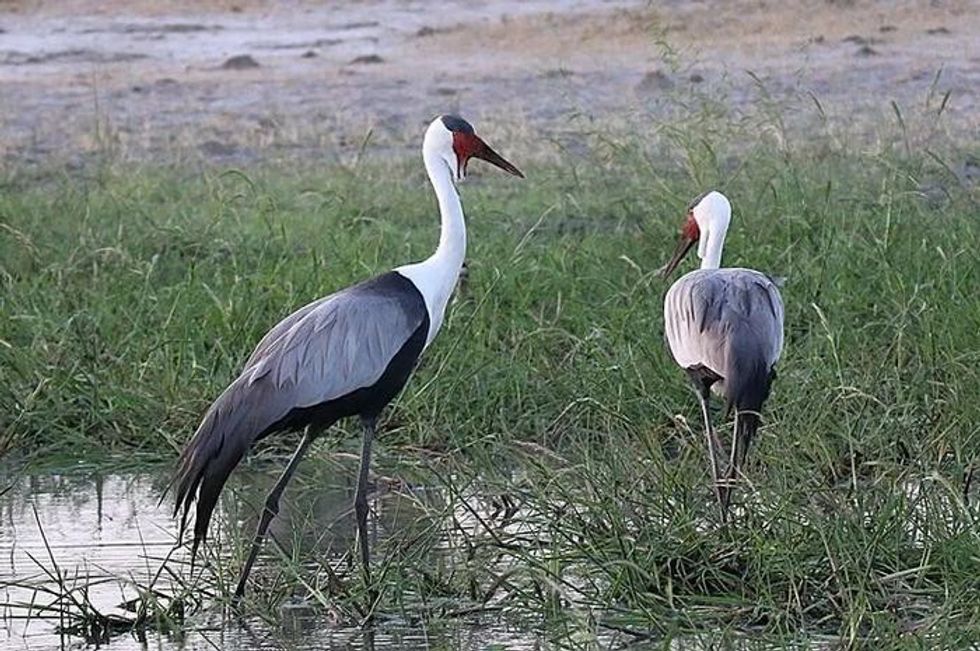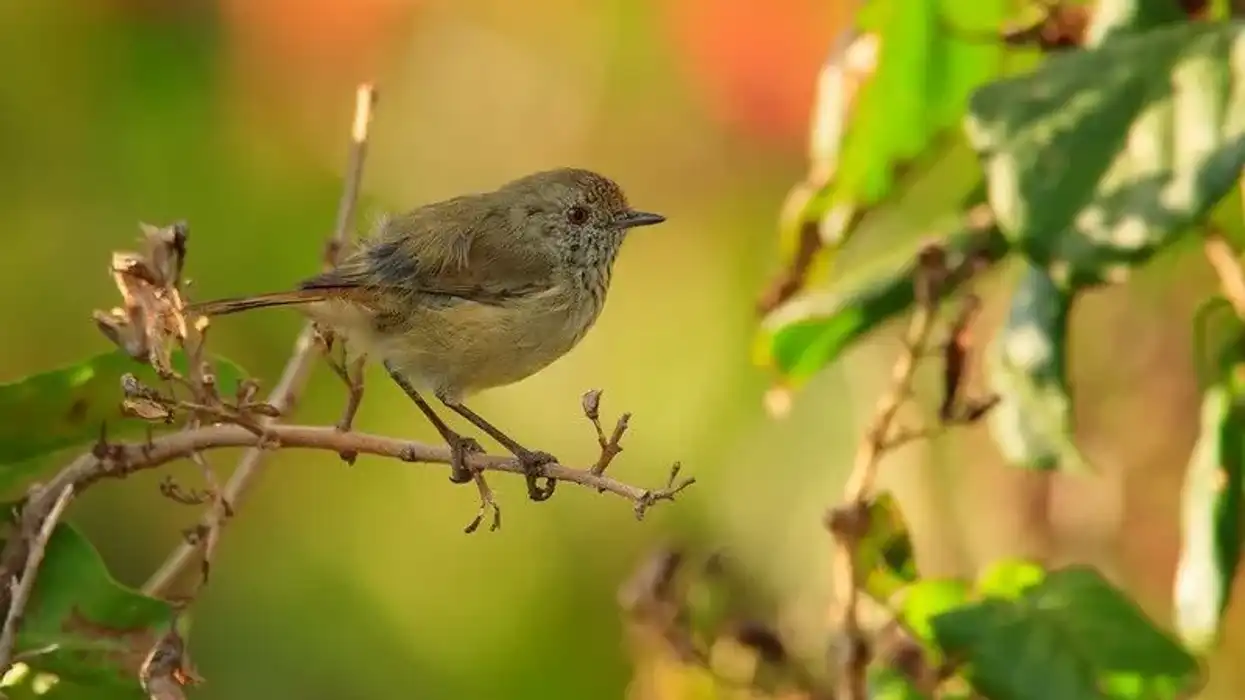The wattled crane (Bugeranus carunculatus or Grus carunculata) belongs to the family Gruidae. It is also referred to as the African crane species.
This threatened species is found in 11 sub-Saharan countries of Africa that include Zaire, Tanzania, Mozambique, Angola, South Africa, and Namibia. An isolated population of this bird is also found in Ethiopia's highlands.
Most of the population is found in Zambia and the Okavango Delta of Botswana. The types of habitat these cranes inhabit include wetlands, grasslands, river basins, and marshes with sedges.
The breeding habitat is shallow wetlands. The reproduction of this bird depends on the water level and the breeding season occurs from July to August in Ethiopia and around April to October for the southern part of the population. The nest is placed in an open area and made with aquatic vegetation.
This bird species is monogamous and one to two eggs are laid. The incubation period of these eggs takes place for about 33-36 days and is known to be done by both the parents.
Fledging takes place about three to four months after birth. The juveniles live in family groups and mature sexually at the age of about four to eight.
Males are known to have red facial bare skin which is darker than the females. They have a long white neck and two white wattles that hang from the throat. The head of this crane is white.
The back and wings of these cranes are dusty gray in color, while the breast is white-colored. The body color of juveniles is similar to the adults but has a pale yellowish color on their bodies.
Not many animals prey on these birds but jackals are known to hunt the chicks of these birds. The diet of the African wattled crane consists of aquatic insects and vegetation. The life span of this crane is around 20-30 years in the wild.
Continue reading for more interesting facts about this bird. Also, check our our other articles about the common murre and sanderling too.
Wattled Crane Interesting Facts
What type of animal is a wattled crane?
A wattled crane is a bird.
What class of animal does a wattled crane belong to?
The wattled crane belongs to the class of Aves of birds.
How many wattled cranes are there in the world?
It is believed that there are only 7000 of these birds or individuals in the world.
Where does a wattled crane live?
This crane species is found in, or the wattled crane range map, around 11 sub-Saharan countries of Africa that include Zaire, Tanzania, Botswana, Mozambique, Angola, South Africa, and Namibia. An isolated population of this bird is also found in Ethiopia's highlands. Most of the population is found in Zambia and the Okavango Delta of Botswana.
What is a wattled crane's habitat?
The primary habitat of this crane species is known to be wetlands and grasslands. This species inhabits wet areas like river basins and the breeding habitat of this species is known to be shallow wetlands or habitats like marshes with sedge and grass.
Who do wattled cranes live with?
Cranes are known to be mostly solitary and can often be spotted in pairs or flocks.
How long does a wattled crane live?
It is believed that these cranes live for about 20-30 years in the wild.
How do they reproduce?
The breeding season depends on the water levels and is from July to August in Ethiopia and around April to October for the southern part of the population. Wattled cranes have a monogamous breeding system and the pair bonds for long term and often lasts for life.
Courtship rituals involve running, jumping, bowing, and also tossing plant items. The building of the nest is also known to be a part of the mating ritual. The nests are placed around 1640 ft (500 m) away from other ones.
The nest is made of aquatic vegetation and is placed in open water. The pairs are known to be territorial.
One to two eggs are laid and it has been observed that mostly one chick is reared. Incubation takes place for around 33-36 days and is done by both parents.
After hatching, the chicks are known to be able to swim, walk, and follow their parents for foraging. Fledging takes place when they are three to four months old. The juveniles are known to live in family groups and mature sexually at the age of about four to eight.
What is their conservation status?
The wattled crane conservation status of these birds is under the Vulnerable category of status.
Wattled Crane Fun Facts
What do wattled cranes look like?
Adults males and females are known to look similar, only the males tend to have dark red bare skin than females. These cranes have a white head but have a feathered section above the eyes and on the crown and this section is dark gray in color.
These cranes have two white-colored feathered wattles hanging from the upper throat. The neck of these cranes is long and white in color.
The midsection part of the body includes mantles, tail coverts, primaries, secondaries, and tail which are all different shades of black. The wings and the back are dusty gray colored and the breast is white-colored. The legs and toes of this crane are black or dark gray in color.
The bill is light red or brown in color. The iris is dark orange in color.
The young ones or the chicks have completely white heads and their plumage is known to be lighter than the adults. They also lack bare skin like the adults.
How cute are they?
These cranes are not considered cute.
How do they communicate?
This crane species is known to communicate in the same way as other bird species. They are known to produce sounds and calls to communicate with each other.
How big is a wattled crane?
This crane species is known to be around 43-55 in (110-140 cm) long and 59-69 in (150-175 cm) tall and is smaller than the red-crowned crane and the sarus crane.
How fast can a wattled crane fly?
The exact speed of these cranes is unknown but the wingspan of a wattled crane is around 91-102 in (230–260 cm).
How much does a wattled crane weigh?
The weight of a wattled crane is around 14-20 lb (6.4-9 kg).
What are the male and female names of the species?
There are no specific names for the males and females of the wattled crane species.
What would you call a baby wattled crane?
There is no particular name for a baby of this crane but they may be referred to as chicks, young ones, or juveniles.
What do they eat?
The diet of this crane consists of aquatic vegetation and insects. They are also known to feed on snakes and frogs. The primary food sources in their diet are water lilies or sedge vegetation.
Are they poisonous?
Wattled cranes are not considered poisonous.
Would they make a good pet?
Not much is known about wattled cranes as pets. However as these wattles are listed as a Vulnerable species, it is best that they remain in the wild.
Did you know...
John Friedrich Gmelin, a German naturalist, is known to be the first one to formally describe this crane species in 1789 under the binomial or scientific name Ardea carunculata. Initially, the wattled crane was put under the name of its own genus Bugeranus.
Wattled cranes are known to be the tallest flying bird that is native to Africa.
It is believed that in April 2018 in Angola, a new population of wattled cranes was discovered.
The movements of wattled cranes depend on the local water situations, instead of seasonal temperature variations. It has also been observed that the migration of these cranes takes place from high to low plateaus in Mozambique.
Jackals are known to be predators of the young ones or chicks of this species.
Some other species that are known to be associated with this crane species include the antelope, lechwe, and spur-winged goose because of their common habitats and dietary choices.
This crane species is known to have a high-pitched call like a bugle-like call and a far-carrying or going 'kwaamk'.
During any threat or danger, the parents hide their chicks in tall grass.
Outside the breeding season, these wattles gather in flocks and their flocks might consist of 10 or more cranes sometimes.
Wattled cranes formerly were known to inhabit a greater range of southern Africa and the decline has been attributed to cattle-herding before the European settlement.
How did the wattled crane get its name?
This species of wattles are named because of their wattle that is known to dangle from the throat. This wattle is known to be white in color.
Are wattled cranes endangered?
The wattled cranes are listed as Vulnerable and the major threats they face are habitat loss, destruction, or alteration. Other threats include powerline collisions and the illegal collection of eggs. Wattled cranes have been placed under the Agreement on the Conservation of African-Eurasian Migratory Waterbirds (AEWA).
Here at Kidadl, we have carefully created lots of interesting family-friendly animal facts for everyone to discover! Learn more about some other birds from our green heron facts and Australian pelican facts pages.
You can even occupy yourself at home by coloring in one of our free printable bird coloring pages.










